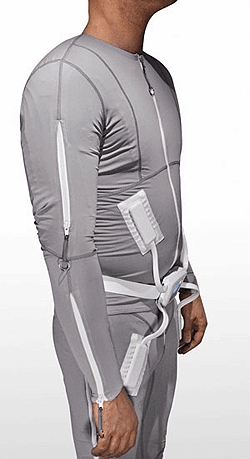The Mollii garment is said to provide an alternative to painful treatments and surgery by treating the body with electrical stimulation to ease tension and spasms, resulting in reduced pain perception and increased mobility.
The idea originated with Fredrik Lundqvist, a Swedish chiropractor who worked on the rehabilitation of brain-damaged patients. Lundqvist struck upon the idea of sewing electrical stimuli – similar to TENS (transcutaneous electrical nerve stimulation) electrodes – into garments that the patient can wear.

He turned to Johan Gawell and Jonas Wistrand, researchers at KTH Royal Institute of Technology’s Department of Machine Design, who produced a prototype and are working on the development of Mollii.
Designed with ordinary swimsuit material, the body suit has conductive elastic sewn into it, with electrodes located at the major muscles.
Battery-powered light current is conducted via silver wires to 58 electrodes attached to the inside of the garment, which in turn stimulate as many as distinct 42 muscles, according to the patient’s needs. Batteries are placed in a small control box fitted at the waistband.
‘The idea is that the clothes should be used for a few hours, three times a week, and the effect is expected to last for up to two days,’ Lundqvist said in a statement.
The garment has been shown to be highly effective in patient examinations performed in collaboration with a PhD student from Stockholm’s Karolinska Institute.
Stroke patients with paralysis on one side have been found to gain increased mobility in spastic limbs, with improved gait and their arms and hands working better after treatment.
‘As a bonus, the patients often sleep better, and their pharyngeal motor skills and speech improved after using Mollii,’ Lundqvist said. ‘It can also help children with physical disabilities or motor difficulties in the feet, such as constantly walking on toes or with their feet at inward angles.’
Treating patients with movement difficulties and pain due to neurological damage can often require surgery, injections of botolinumtoxin (neurotoxin) or strong medications.
‘These treatments mean high costs and side effects, while our clothes are simple and safe to use,’ Lundqvist said. ‘You can reduce the number of hospital visits because the therapy can be performed at home. And when the mobility increases, there is less need for walkers or wheelchairs.’
Mollii is an approved CE marked medical device, but independent clinical tests have yet been performed. The company behind the treatment, Inerventions, has launched a scientific study of the clinical effectiveness of the garment in partnership with Sweden’s Rehab Medical clinics. Results are anticipated in 2014.





Glasgow trial explores AR cues for autonomous road safety
They've ploughed into a few vulnerable road users in the past. Making that less likely will make it spectacularly easy to stop the traffic for...